A Ramble Through Whitfield and Chunal.
In 1899 the Glossop-dale Co-operative Society arranged for Robert Hamnett to guide them on a ramble from Norfolk Square, through Whitfield and Chunal to Hobroyd.
The ramble took place on Saturday 10th June, the following account being published in the Glossop Advertiser on 16th June 1899.
Illustrations are from my personal collection.
On Saturday afternoon last, about fifty members of the Co-operative Society, including members of the Women's Guild, took part in a very interesting ramble promoted by the Educational Committee, who were fortunate in securing as leader Mr. Robert Hamnett, of Norfolk-street, whose fame as an antiquarian and knowledge of ancient lore are very widely known, particularly to the leaders of research in Lancashire and Cheshire. The party assembled in Norfolk Square at three o'clock, and Mr. Hamnett gave the following able account of the various places visited.
Sixty-two years ago, said Mr. Hamnett, the Square presented a far different appearance to what it does now. At that time it was a garden belonging to the Norfolk Arms. It contained a bowling-green, where those who had any spare time (mostly those generally termed " the middle classes") played the game of bowls, a game which seems to have died a natural death so far as Glossop is concerned, the other once-popular bowling green, viz., that at the "Howard Arms and Bowling Green Inn," being occupied by a stable. On the side of the garden, where the Co-operative buildings now stand, was a stone fence wall, which little naughty boys were in the habit of climbing over when the fruit was ripe, and testing surreptitiously the quality of Mr. Joseph Oates' garden property. The garden had some high trees in it, a harbouring place for birds, which, I am sorry to say, were shot by so-called sportsmen. Near the site of the Masonic Club, in Henry Street, was a fish pond, which sometimes furnished sport for the disciples of Isaak Walton, whose "Compleat Angler" has furnished instruction and amusement for the last 240 years to all lovers of the rod and line. Where the Town Hall, Market, and shops now stand were gardens and a field of oats, the hedge coming up to the present line of buildings, presenting to the eye a scene of rustic simplicity and beauty, which has now disappeared to give place to one of more practical utility. The Square, guarded by its iron sentries (stumps), which, bye-the-bye, were cast at the Foundry, George-street, and furnish little boys with a test for their leaping powers, has witnessed many exciting scenes. The Blue Ribbon and Salvation Army, and representatives of other religious bodies have endeavoured from this spot to awaken and arouse religious enthusiasm in the hearts of Glossopians and others who have listened to their exhortations. Few of the old temperance veterans but what at some time or other have from here, and from their point of view, exposed the iniquities of the liquor traffic. Here have assembled the members of the various friendly societies, with the banners and emblems of their Orders, led by brass and other bands of various merit, to give colour and appearance to some event, or other landmark in our local history. The children of the Sunday Schools have here met, and raised up their voices in praise of their Maker, who loves them better, alas, than He Himself is loved. The Square has not always been occupied by a peaceful assembly. The Cotton Famine Riot, when an attempt was made to sell by auction barrels of flour, the 1868 General Election, and many a Municipal Election Day have shown the Square under a different aspect.
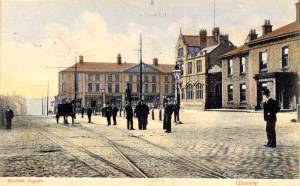
Norfolk Square
The Norfolk Arms.
When the turnpike road to Sheffield was opened on the 23rd day of August, 1821, the "Howard Arms and Bowling Green Inn" was the only licensed house on the route in Glossop, and it was here on the 27th day of May, 1822, that sixty persons had dinner to celebrate the event of the first mail coach from Manchester to Sheffield having passed through what was then the village of Glossop. The Howard Arms had a few years previously been a farmhouse, and was not then adapted to a coaching business, hence the necessity for a more commodious and convenient place. A number of gentlemen at Sheffield formed a Tontine Association, and built the Norfolk Arms. Some of our old residents still sometimes call “The Tontine,” a name by which it was known for years after its erection. The Norfolk Arms has served various purposes besides its licensing business. In its rooms many important matters affecting the prosperity and welfare of the town have been mooted and planned before being put before the inhabitants for their decision. On the 1st July and the 24th September, 1836, the local gentry here met gentlemen from Manchester and Sheffield, the result of their deliberations being the construction of the Manchester, Sheffield, and Lincolnshire Railway, now the Great Central, which has done so much to further the prosperity of all classes in the neighbourhood. Here the "Court Leet" of the Manor was held, when matters of dispute between tenants, and other things within the jurisdiction of the Court were settled, followed subsequently by a dinner, to which the jury and others composing the Court did ample justice, frequently returning home when the sun was just peeping over the hills, the licensing laws permitting them at that time to keep open as long as they wanted. The Court for granting or refusing licenses was formerly held at the Norfolk, whilst in a portion of the back premises the old Universal School and St. James' Sunday School had their birth. One of the earliest proprietors, Mr. Joseph Oates, was of an enterprising nature. He it was who, on the 19th May, 1824, commenced running the Market Coach every Tuesday and Saturday morning to Manchester, and which continued running until the branch railway was opened on the 18th July, 1845. A robbery took place on the 8th August, 1833, when Mr. Oates seized one of the burglars and held him until assistance arrived, and the burglar secured. The man was committed, and a rather singular occurrence took place whilst the prisoner was being conveyed to the County gaol at Derby. At that Period prisoners were conveyed by the village constable in the coach to Derby. In this particular case the constable fell asleep, and on waking up was in a great predicament—the prisoner was missing, and no one had observed him leave the coach. There was no help for it but to proceed to the next stage, which was only a short distance away, and procure a horse to try and find him. However, to the surprise of everyone the prisoner came up running, breath-less, and in fear lest he should miss the coach! His explanation was that his cap had blown off by the wind. He had left the coach to find it, and ran two miles before he could catch up with it again. He got two years' imprisonment. I am afraid not many burglars of the present time would follow his example.
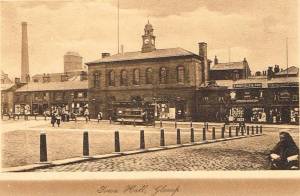
Town Hall
The Glossop Town Hall is 497 feet above the sea level. The foundation stone was laid on the 28th June, 1838, the day our gracious Queen Victoria was crowned. The Hall, although it cost £8,500, has no pretentions to any architectural beauty, but the motto of the Duke of Norfolk (who built the Hall) "Sola Virtes Invicta," i.e., “Alone virtue is invincible,” is well worthy of remembrance both by young and old. Immediately after this event shops began to be built on each side of the Hall, the Manchester and District Banking Company building a bank, now occupied by Mr. Bradbury, chemist. The Company had previously hired a room in the Norfolk Arms for two days per week to transact the amount of business which was then done. We have now two handsome barks, a great contrast to the original building of sixty years ago. It was intended that the corner shop, now occupied by Mr. Hudson, should be of the same design as the bank, so as to show a uniform front, but for some reason or other it was never carried out. There are prints in existence which show the original intention. At that time the principal draper's shop was Mr. Howe's, son of the then Vicar of Glossop. He carried on business in the shop recently demolished by Mr. Isaac Jackson, and lately occupied by Messrs. Brownson’s—an unpretentious , building, but no doubt suitable for the purposes for which it was erected. In 1844 the Lord of the Manor obtained a Market Act, and on the 19th July, 1845, the market was opened and was enlarged in 1854. The ground was of a rough character, descending abruptly to the brook course; a wall was built, which is now arched over, the hollows filled up, and the looks of the place entirely changed. Before this was done [text indistinct] the first Wakes at Howardtown was held on the ground in 1839, an event which even now is looked back to by some aged Old Glossop people with a certain amount of bitterness, all their attempts to transfer the Wakes back to its old place having failed.
Victoria Bridge.
The present bridge was erected in 1837, the same year the Queen came to the throne. The old bridge was destroyed by the Hurst flood, which took place on Wednesday, the 30th July, 1834. It was a little to the east of the present one, that the old road passing over it by Burgess' Mill, a white-washed one, formerly owned by George Burgess, who on the 25th June, 1811, married the eldest daughter of the Rev. Christopher Howe. Soon after the bridge was opened, on the 29th March, 1838, a soldier created a great sensation by attempting to murder the village constable and killing himself near to the bridge. On the 31st December, 1848, an old pensioner named Doxey was found dead in the brook. It is supposed that he had been thrown over the bridge, but the case was not clearly proved, the parties accused being acquitted at the Assizes. In the early part of the century the old bridge was a “Pack saddle bridge,” and was very difficult of access from "Little Moor Hill." On the 15th of April, 1824, the Select Vestry granted Mr. Thomas Ellison £15 for the widening and improvement of the bridge. Could these persons return again just for one brief moment they would fail to recognise the spot.
Whitfield.
We are now in the township of Whitfield. Prior to the time of the Domesday Book, 1086, it belonged to King Edward. Its area is 2,608 acres, and contained in 1803 fifty houses. In 1318 Matilda de Witfield had two bovates of land, her fee as ‘Forester of Witfield,' as it was then called. Her ancestors had been appointed by William I, surnamed the ‘Conqueror.' In 1300 Thomas le Ragged conveyed it to John Foljambe, and in 1810 many enclosures were made, and awarded to the in-habitants, but there had been enclosures made before then. 'Free Town' most probably derives its name from the large quantity of free-hold land there is in the vicinity, to distinguish it from the other 'Towns,' viz., Rough Town, Mill Town, Howard Town, Jerry Town, Charles Town, Lean Town, and Top o'th Town, which are mainly leaseholds.
This portion of road at the 'Bank' was made by the Romans nearly 1800 years ago. It is of similar construction, and forms part of the military way from Melandra Castle to Brough. Along this road have passed portions of Rome's Imperial legions, and ancient Britons, on their way to Deva (Chester) to serve as auxiliary forces abroad, assisting to conquer other nations as untutored as themselves. I have read that at the besieging of Jerusalem there were 12,000 Britons present ; if that is true, many of these may have passed this way.
Dearnally Row.
No. 1 to 23, Kershaw Street, known formerly by the name of Dearnally Row, was built in 1841 by John Dearnally, who on the 27th January, 1800, became schoolmaster at Whitfield Endowed School, a position he retained until his death, which took place on the 4th of January, 1843. His scholars nicknamed 'him old crab fist' from a deformity to one of his hands, but at that time few people went by their proper names. The length of time he was schoolmaster gave him an opportunity to impress his individuality on his scholars, and he is remembered by many of them to this day.
Kershaw Institute.
This building was built in 1859 by the late Robert Kershaw, who died on the 13th January, 1864, at Slatelands House, which he had not long before built. Born at Hollingworth on the 18th December, 1804, his life was one which will compare favourably with any gone before and since in Glossop. It reminds me of Critchley Prince's lines on the death of a good man :--
“When weeping eyes are gazing on his face;
When pale but fervent lips stir the hush'd air
With blessings on his head; when kindred hearts
Throb with unuttered feelings for his loss;
And—oh, triumphant hour for him! —when all
The recollections of a well-spent life
Rich with the hues of charity and love,
Crowd back to gild his passage to the tomb!”
He lived not for himself, but for others. For over forty years he was a teacher, not from mercenary motives, but from pure love of his fellow men. The Institute is a visible testimony of his convictions. Commencing about 1848 in St. James' School, he had a night school there for about ten years, when some difficulty arising with the Church officials, he took the 'bull by the horns,' as the saying is and solved all vexatious questions by building the present Institute at a cost to himself of £400. He furnished it with a library of 900 volumes, which in 1859 had cost £260. That the Institute has been of incalculable value to the in-habitants of Glossop cannot be denied by anyone, and that its usefulness may long continue is the wish of every sensible working man.
28, Freetown.
This house, formerly a farm house, is the oldest house in Freetown, and was built in 1809. Within the memory of many now living Freetown was a long narrow lane continuing down Hollincross Lane, the hedge on each side being high and of holly. The Orange Society were amongst the first to build in this neighbourhood, one side of Unity Street being known as Orange Row. The property was afterwards purchased by the Oddfellows Society, and it is sometimes called Oddfellows Row, whilst its proper name, Unity Street, is evidently connected with and derived from that Society. Houses 1 to 13, Charlestown road, were called 'Noon Sun,' a name not now often met with, and where the Crown Inn and the houses adjoining now stands was formerly a plantation, containing a saw pit.
St. James' Church.
This church was built in 1846, at a cost of £4,500, and is too well known for me to occupy your time on this occasion in describing it.
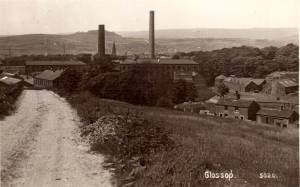
Turn Lee
Turn Lee.
In 1811 the old mill at Turn Lee was worked as a cotton mill by John and William Kershaw. In 1825 John and Joseph Bennett were using it for their miscellaneous business of wool carders, fur cleaners, scale board and tip manufacturers, &c. In 1841 they were also cotton spinners. Their failure was one of the heaviest in this district, their workpeople being the worst sufferers. In 1846 Samuel Kershaw and Co.
occupied it as paper makers, &c. In 1852 the Turn Lee Mill Company were spinning cotton in it. In 1865 Thomas Hamer Ibbotson was there paper making, followed shortly afterwards by Cassell Petter and Galpin, who about 1871 turned it over to Olive and Partington, the latter gentleman being mainly responsible for its present extent and prosperity.
Charlestown Mill.
This mill, built by the Hadfields, of Lees Hall, has likewise had many occupiers. In 1811 a George Robinson was manufacturing cotton goods. In 1825 James and William Kershaw were spinning cotton; in 1828 it was Wood and Kershaw (same business); in 1841 Robert Kershaw and Co.; in 1846 George Fox was trying to make it pay by paper making; in 1852 Christopher Greaves Middleton was doing the same; in 1865 Middleton had taken his manager, George Fox, into partnership; and it is now called Walton's Bleach Mill.
Bury-me-wick Mill.
Chunal Mill, or Bury-me-wick Mill—strange name,—but better known now as Dover Mill, was built by the Shaws. John Shaw prior to 1823 occupied it, and then it became untenanted for some time, when Mary Shaw and Sons restarted it, they were here in 1828. After the death of Mary, James and his brothers continued the business until Friday, the 18th of October, 1833, when the mills were totally destroyed by fire. It was afterwards rebuilt and occupied in 1859 by the Turn Lee Mill Company. In 1865 George Tomlinson and others since then have tried to make their independency here, but none seems to have done so. It now forms part of Messrs. Partington's.
Chunal.
Chunal is a very ancient hamlet, mentioned in Domesday Book as Coelhal, an Anglo-Saxon name. It will always he remembered as the birthplace of Joseph Hague, a man who from a small beginning, by his integrity, industry, and perseverance, amassed a large fortune in London. Returning to his native hills, he passed the remainder of his life at Park Hall, where he died on the 12th March, 1786, aged 90 years. He built and endowed Whitfield School, Hague Street, which is so named in remembrance of him, and also left a sum of money, the interest of which under the name ‘of Hague's Charity' is distributed annually. The old Horse Shoe Inn, Chunal, exists no longer as a licensed place, but when kept by Samuel Pickford, blacksmith, was a noted place, many practical jokes having been conceived and carried out under its roof. Pickford was an eccentric character. A friend of his, happening to call in one day when pluck roasting was going on, ventured to ask for a portion, the enticing smell having aroused within him a longing for a taste. To his request all the reply he got was, ‘Smelling's thy share.' Thinking the refusal was a jest, he asked again, but was met with the same reply, ‘Smelling's thy share.' Becoming at last aggravated by this answer, he declared if Pickford would not give him some he would write his epitaph, and forthwith penned the following lines:
Here lies the body of Pickford Sam,
His death is sure, it is no sham;
He made horse shoes and nailed them fast,
But death has nailed him here at last.
He roasted plucks and made them smell,
I hope his soul is not in hell;
He sold both brandy, rum, and gin,
And if he's damned, it's for putting water in.
Chunal plantation of larch and fir trees was planted just a little over 100 years ago. In A.D. 1157 Glossop, in 1308 Chunal, Simmondley, and part of Charlesworth, and 1358 or 1360 the remaining portion of Charlesworth, became the property of the Cistercian Abbey of Basingwerk, near Holywell, Flintshire. Moore in his ‘Monastic Remains,' published in 1791, gives a view of the remains of this abbey, which was dissolved by Henry VIII. in 1537 or 1539, when all the property was taken from the Monks and given to those he thought fit. For 380 years they were the owners of this neighbourhood, but little remains are now visible of their former presence here. The stone called the ‘Abbot's chair' tradition says was placed here by them, which I see no reason to doubt, especially as just over the wall there is the base of a cross, and the land on which we now stand is unenclosed and specially adapted for an assembly of people either for worship or the settling of worldly matters. As I have said before in a previous lecture on ‘Glossop dale' the stone may have marked the boundary of their territory or been a starting point for the ancient ceremony of beating the boundaries. The religions order of the Cistercians was founded in 1098 by Robert, a Benedictine Abbot of Molesme, in Burgundy. Its members increased rapidly, although their rules were extremely severe. They came into England in 1128. They had what we now call a parsonage at Glossop, constructed of wood, also a grange at Charlesworth, where they built the chapel of ease St. Mary Magdalene, now the ‘Top Chapel.' Hayfield and Mellor Churches were built through their influence. Many a walk have the Monks had along this road, which is fitly named Monks Road.
Cown Edge Rocks are 1346 feet high, near the Quarry and Tumulus. If today was the 26th September and we could look back forty years we should see a strange sight on this road, the funeral of a dog, ' Glory Scholes,' which was buried underneath those rocks, one of the most extraordinary affairs of its kind ever known, no less than 100 couples of dogs with crape round their necks, led by men, following the doggy remains. Could we look still further back, nearly 2,000 years ago, we should see on the highest point there, 1346 feet, near the quarry, a group of ancient Britons paying their last respects to some noted warrior or chief. There are several of those Tumulus on the top, one of which was opened over 90 years ago and various remains found, proving their antiquity and genuineness.
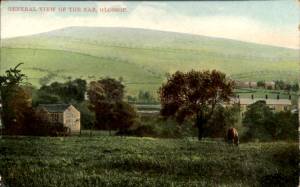
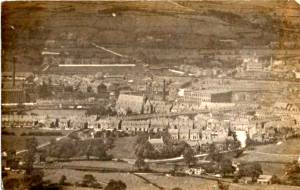
The Nab from Glossop & Glossop from the Nab
Whitely Nab is 1,000 feet high, and from this hill we obtain an excellent view of Glossop-dale. You will now see how appropriate the British or Celtic name of ‘Glossop' is to the district, viz., a shining or bright slope between hills.
Hobroyd was formerly called How broad, then it became Hob Road, and now it bears its present name. The Roman road from Melandra Castle to their Baths at Buxton passed through this place. Traces of it was discovered by the late Samuel Wood, of this place.
Mr. Hamnett's interesting narratives were followed with the keenest attention, and the ramble was greatly enjoyed. At the close of the journey a hearty and unanimous vote of thanks was given Mr. Hamnett on the motion of Mr. William Hill, who expressed the great pleasure the company had experienced under the leadership of Mr. Hamnett, and trusted it would not be the last time they would have his guidance in a similar enjoyable ramble.
Return to GJH.me Home Page, Return to Glossop Area Local Histories index.
Last updated: 4 October 2020





